Installation of water supply from polypropylene pipes: typical wiring diagrams + installation features
Metal pipes are no longer considered the only correct solution for organizing in-house utilities.Increasingly, owners of business facilities are relying on installing water supply systems from polypropylene pipes, which are characterized by affordability and durability.
The choice promises lower financial costs, and the criteria for maintenance and operation of polypropylene seem more attractive compared to metal. But before you start assembling the water circuit, you need to find out the specifics of choosing and installing polymer pipes, don’t you agree?
The article is devoted to solving these issues. We described the characteristics of various pipe products, provided a breakdown of their markings and outlined working wiring diagrams. In addition, the article provides detailed instructions for assembling the pipeline, and also lists the technical nuances of installing a water supply system from PP pipes.
The content of the article:
Distinctive features of polypropylene pipes
It is quite possible to make a seemingly complex water supply system made from polypropylene pipes yourself. But first, it is advisable for the master plumber to obtain as much information as possible on the topic of installing water supply systems based on PP pipes.
Since the main element of the installation process is polypropylene pipes, you should remember that there are products on sale:
- PN10 - single-layer for pressure up to 10 ATI;
- PN20 - single-layer for pressure up to 16 ATI;
- PN30 - three-layer for pressure up to 25 ATI.
PN10. The first type of polypropylene hoses for a working pressure of up to 10 atmospheres is quite suitable for the installation of a cold water supply line for the domestic sector and the construction of water-heated floors.A cold water supply system with a working pressure of up to 10 atmospheres is usually installed from this material.
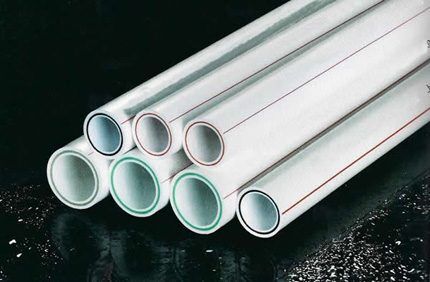
PN10. The pipes are designed for operating pressures up to 16 ATI, and are also used for distributing cold water mains. They can also be used to install hot water supply lines if the maximum temperature in the system does not exceed + 60ºС.
PN20. The modification is represented by more durable products, suitable for the installation of not only cold and hot water supply systems, but also heating circuits. Such polypropylene can be used in systems with increased operating pressure (up to 20 ATI) and coolant temperature up to + 80ºС.
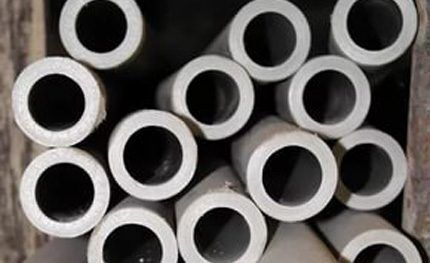
PN25. This pipes for heating systems, but can also be used for hot water supply. Made using the same three-layer technology. Only the reinforcing layer is made of aluminum foil. The operating temperature limit is + 95ºС.
Products under the PN25 brand are positioned as an innovative development, thanks to which it was possible to get rid of a significant drawback of polypropylene hoses - thermal expansion. In fact, these products are a universal product that can be used for installing water pipes of any type.
One should take into account the peculiarity of the installation of such pipes - when soldering, the reinforced layer is removed. Only the polypropylene base can be heated with a soldering iron.
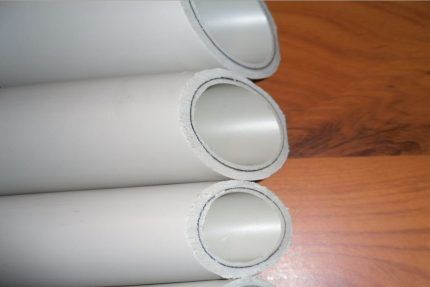
The entire existing range of polypropylene pipes for water supply, as a rule, is labeled based on its specific purpose.
Typically, markings are colored stripes applied directly to the outer wall of the pipe:
- blue/green for cold water supply,
- red/brown for hot water supply or heating,
- orange for any water supply system.
Color marking makes pipe selection easier.
Typical wiring diagrams
There are many circuit solutions for laying out water supply lines made of propylene. Each of the individual schemes is usually considered taking into account the financial costs of construction and with an eye to the technical requirements for the premises of the facility.
Most often, a classic wiring diagram is used, which is the same type in relation to the cold water and hot water lines.

Water is supplied from the riser of the centralized main through a pipe outlet with a shut-off valve installed on it. Next, the system elements are sequentially mounted: filter, reducer, meter, check valve and connected to the distribution manifold.
From the collector, cold or hot water is distributed to plumbing fixtures.This solution is traditionally used when plumbing in the apartment.
Many private households use an autonomous water supply system. Therefore, a departure from traditional circuit solutions in such cases is not excluded. But usually the principle of collector distribution for water supply systems (not heating) remains the same in any case.
Private household boiler systems often provide only a cold water supply. Moreover, instead of a centralized main, the source of cold water can be, for example, a well. Then the wiring diagram could be something like this:
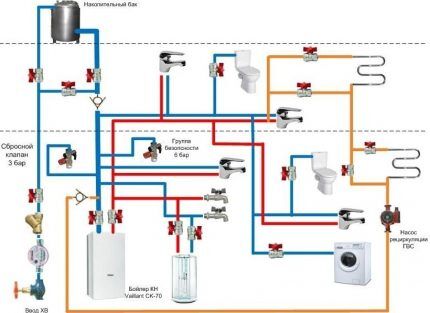
The wiring diagram in any embodiment must provide for the presence of shut-off (shut-off) valves for each individual plumbing fixture. Autonomous type schemes (with boilers or boilers) are characterized by the mandatory presence of bypass lines on devices that carry out a functional process.
Such solutions allow you to quickly switch the system from autonomous mode to centralized supply mode if necessary.
More information about installing water supply in a private house is written in this article.
Features of installation of polypropylene pipes
The installation of a water supply system based on polypropylene pipes, as a rule, is accompanied by the purchase of special tools and a set of elements - fittings, which ensure complete installation. Special tool – polypropylene pipe soldering iron – you can buy or it’s smarter to rent.
The installation of a water supply system from PP pipes requires compliance with a number of technical and technological nuances:
From the set of necessary tools you will need pipe cutter (special scissors). However, it is quite acceptable to trim polypropylene sleeves with a hacksaw. For measurements you will need a construction tape, as well as a marker (pencil) or something similar.
An angled ruler or protractor will not be superfluous in installation work. For a complete set you also need wrenches or an adjustable wrench.
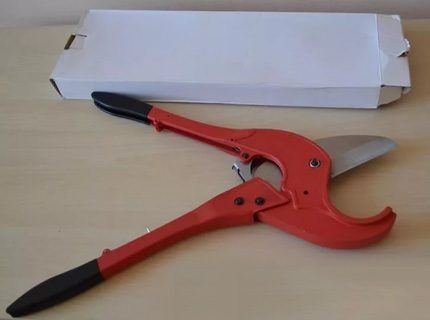
The process of assembling polypropylene pipes does not require any special technological actions from the plumber. But, some experience with soldering polypropylene is still necessary. A complete lack of skills threatens to result in unpleasant consequences for the operation of the water supply system in the future.
And the sequence of work is approximately as follows:
- The water line pipe is cut to size.
- The cutting and joining area is cleared of burrs.
- The required fitting element is selected and adjusted.
- The polypropylene soldering iron is equipped with appropriate nozzles.
- Turn on the heating at the soldering station - heating limit is 260ºС).
- The elements to be joined (fitting and pipe end) are brought into contact with the nozzles.
- Heat them for several seconds (4-10), depending on the wall thickness.
- Remove from the nozzles and quickly connect by hand by inserting the end of the pipe into the fitting body until it stops.
The peculiarity of the last action is that it must be performed quickly enough with clear fixation of the pipe and fitting in one position. After connecting the elements, you should wait at least 30 seconds. This time is enough to harden the heated areas and tightly connect them to each other.
Installation of any type of water supply system from polypropylene pipes is considered to be carried out competently when the lines are drawn from plumbing fixtures to the main source of water. The installation of pipes should be carried out as straight as possible, parallel to the floor or walls of the building.
If the DHW and hot water mains are located in close proximity to one another, it is recommended that the hot water line be installed above the DHW line.
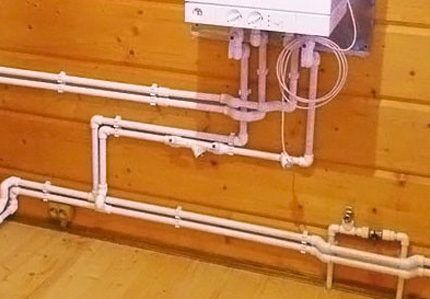
Polypropylene pipes, when compared with a metal pipe, have significantly less rigidity. Therefore, when installing polypropylene, attention should be paid to reliable fastening of the pipelines to the base. Mounting support brackets must be placed every 1.5-2 m of the pipeline line.
It is advisable to build water mains taking into account minimal loads on the pipelines. It is not recommended to bend the body of a polypropylene pipe by heating the bend in order to bypass an obstacle in this way. To solve such problems, you should use special fittings - corner or bypass.
The socket connection of parts of a polypropylene pipeline is made welding method:
PP fittings for water supply systems
The term fitting is taken from English. Literally translated: to mount, adjust, assemble. Structurally, the fitting is a component of a pipeline, in particular made of polypropylene.
This component can take the form of an angle (90º or 120º), tee, cross, etc. There are fittings with threaded inserts for connecting shut-off and other valves. There are special bypass elements that allow you to carefully bypass the places where one pipe bumps into another.
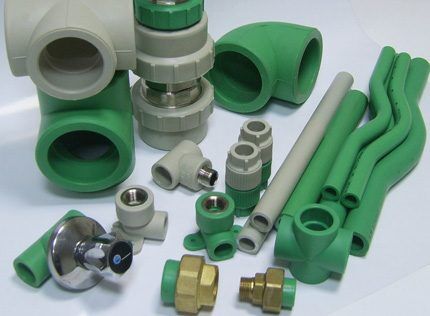
Using any of these mounting elements, it is convenient to build water supply wiring diagrams in almost any configuration.So, to connect one polypropylene pipe to another in a straight line, a coupling is used.
The same fitting is used if it is necessary to make a transition from a pipe of one diameter to a pipe of another diameter in a straight section. It is easy to connect pipes with a bend using corner fittings.
Issued fittings of different types for installation of water supply systems using polypropylene pipes. If one type of such elements is intended for use for soldering, another type is used for mechanical threaded connections.
Fittings for mechanical threaded connections allow you to create a completely strong, reliable connection using force crimping, eliminating soldering technology from the process.

In addition to the threaded connecting technique, the technology of gluing water supply parts is often used. For example, using special glue, tees and polypropylene pipes, you can easily make a distribution manifold for cold water supply with your own hands.
The actions of a master plumber in this case boil down to the following steps:
- The pipe is cut to size and deburred.
- The surface of the pipe at the junction is degreased.
- A layer of glue is evenly applied to the surface.
- The end of the pipe is inserted into the fitting until it stops.
Glue drying time is 20-25 minutes.
Conclusions and useful video on the topic
You will learn useful tips on proper welding of PP pipes from the following video clip:
It is obvious that the introduction of polypropylene pipes into the composition of constantly used plumbing materials was a kind of technological revolution. From now on, it became possible to build water pipelines with a high economic effect. At the same time, reliability and quality remained at the level of the same metal pipes.
The only limitation for propylene is temperature. But in the domestic sector, the temperature parameters are quite consistent with the characteristics of polypropylene pipes.
Do you have personal experience installing water pipes from polypropylene pipes? Do you want to share your accumulated knowledge or ask questions on the topic? Please leave comments and participate in discussions - the feedback form is located below.




HM interesting! I didn’t even know that there was such a technology for gluing plumbing parts. We usually screw everything on with a threaded connection. We will need to introduce this technique into our team)
A mobile soldering iron is a necessary thing! You don’t need to carry pipes all the time for soldering, as before in the 90s, I remember our soldering iron weighed 40 kg. It's not a soldering iron, but almost a machine. Now of course technology wow!!
Yes, the technology is, of course, great. I've even mastered it already. In the summer I replaced the water supply in the house myself. First, I studied the instructions from the Internet. Here Sanek taught in a video how to solder polypropylene pipes. I bought a soldering iron, pipes, elements for joining, and off I went. Everything turned out as it should. The only inconvenience was that during the soldering process a very unpleasant, strong smell of melted polypropylene is released. I think that breathing them is not only unpleasant, but also harmful. My wife grumbled that I wanted to poison everyone.It was good that it was warm and all the windows and doors were open. But I didn’t have to hire a welder, saving money in terms of money.
The installation looks quite simple. But buying or renting a soldering iron for PP pipes is a question. On the one hand, it’s not a fact that it will be useful more than once, on the other hand, the price is adequate, you can buy it just in case.
In this article, I quote: “If the DHW and hot water mains are located in close proximity to one another, it is recommended that the hot water line be mounted ABOVE the DHW line.”
And in the other, on the contrary, hot water supply is above cold water supply. It seems more logical, since condensation will not form on the “hot” pipe.
If you do not use thermal insulation on the pipes, then condensation will definitely form on the cold water pipe located ABOVE the DHW pipe, so it should be the other way around